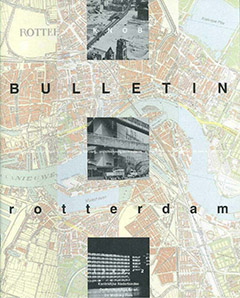Indexering ESCI / Scopus


G.M. Andela: Het Monumenten Inventarisatie Project in Rotterdam. J.E. Bosma en G. Hovingh: Rotterdam in de overgang, stedebouwkunde tussen identiteit en imago. M.C. van Trierum: Dertig jaar regionaal archeologisch onderzoek in Rotterdam en het Maasmondgebied. F.W. van Voorden: De wederopbouw van de geschiedenis. M. Panman: Een kunstwerk onder de Nieuwe Maas.
Within the framework of the Project Stock-taking of Monuments (MIP), 1850-1940 research has been executed in Rotterdam. The researchers started with a study on the general development of the town comprising her geography, the historical town, infrastructure, trade and shipping, industrial development, sector of services, culture, town-planning and architectural development.
The transformation of Rotterdam's harbour into a transit harbour of world stature as well as urban extensions brought about expansive spatial development during the period 1850-1940. The first planned...
The urban identity of Rotterdam certainly cannot be defined in terms of historical fixation. The notion identity is synonymous with the evolutionary way urban space and human activities are being exploited. As opposed to the imago of the town whereby architecture and town-planning are greatly form defining identity is a much more complex notion combining social and psychological values and geographically determined urban spaces.
European Darwinism makes competing towns handle marketing techniques to attract business and population. Also Rotterdam can be characterized as a...
With the institution of BOOR, the Office for Archaeological research of Municipal works Rotterdam in 1960, ing. C. Hoek was the first archaeologist in municipal service. Rotterdam being a world harbour characterized by urban and industrial growth, from the beginning archaeological research comprised the entire region.
BOOR's regional action has been arranged formally through the Coordination Advisory Committee concerning archaeological research within the department of Rotterdam. Different municipalities and social sections are represented in this committee, which discusses the...
In may 1940 a bombardment almost totally destroyed the urban functions of Rotterdam's town-centre. Already during the war, the rebuilding of the town was being characterized by a definitive break with the past. In present-day Rotterdam history contrasts sharply with the new. Because of their scarceness, the few monuments the new Rotterdam possesses symbolize the town's history in the first place. This uniqueness requires a special approach at restoration, of which several cultural aspects are treated in this article.
Thus the experience and interpretation of history in the built...
The tunnel below the river the Nieuwe Maas not only is a civil-technical achievement. Connecting both banks of the Maas the tunnel is an element to improve the coherence in Rotterdam's urban conglomerate of centre, harbours and housing areas. As Holland's first tunnel below water-level (1937-'42) this tunnel moreover has to be seen as a technical object of prestige.
To improve contact between the town- and harbour developments on the left bank with the mother town on the right side ir. L. W. H. van Dijk , director of Municipal Works in 1929 proposed to lay out a tunnel in the...


open access mogelijk gemaakt door Stichting OpenAccess
